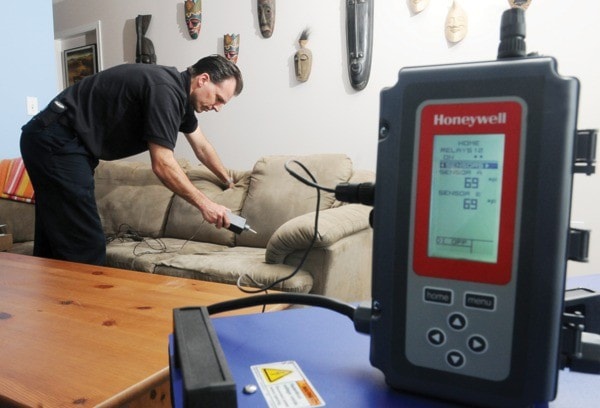The bedbugs are biting and you’re itching all over – so who you going to call?
Try the bug busters – at Assured Thermal Solutions.
The new Maple Ridge company can set up its heavy-duty heaters and fans, heat up your home or apartment to 58 C and in about eight hours and kill the bugs.
Brett Johnston, after decades in the business, started the company about three months ago and has only two-and-a half employees.
He doesn’t expect his company to stay small for long, though.
He figures the growth of the new company should match the spread of the pests.
“They’re in single family homes, they’re in five-star hotels, they’re in much less than five-star hotels. They’re showing up in planes, trains, automobiles, theatres – almost any place that people spend significant amounts of time.
“Bedbugs are really good hitchhikers. They feed off people. That’s what they do. They’re a pest of people.”
Bedbugs drew headlines recently after outbreaks in the Downtown Eastside and more recently in connection with drug-resistant organisms found in five bedbugs from that area.
The latter was described by two Canadian doctors in a June letter that appears in the Emerging Infections Diseases produced by the U.S. Centers for Disease Control and Prevention.
The doctors found methicillin-resistant Staphylococcus aureus (MRSA) in the bedbugs – however, they found no proof the bugs transmitted disease to people, although they said that could be possible.
Johnston says the term “epidemic” is bandied about to describe the spread of bedbugs. He agrees with that description.
“It’s grown massively in the past five years.”
While the creatures weren’t a worry a decade ago and had been all but wiped out in the western world after the Second World War, the growth in global travel, the decrease in use of organo-phosphate pesticides and resistance to DDT, has seen the bug bite back.
Traditional treatments have been to blast the bugs with pesticides, but many now are resistant to those. And while an application of chrysanthemum-based pyrethrin or their chemical copies pyrethroids will kill on contact, that doesn’t solve the problem of bugs hiding beneath the baseboards, safe from the sprayer’s nozzle. That often requires follow-up treatments to blast the bugs that have since hatched. The eggs don’t die from that.
There’s no escape from heat, however.
“As long as you get it hot enough, long enough … as long as you hit their thermal death points in all the spots they could be, you will succeed,” Johnston said.
“It’s just that easy.”
The death point for adult bedbugs is 48C, and for eggs, it’s 50C. “If you hit those magic temperatures and hold it there for 20 minutes everywhere the bugs are, you will kill all of them in one shot.”
To hit such temperatures in all the hidden spots requires heating the ambient air in the house to 58C. That’s well below the melting point of your CDs or TV. A sauna gets up to about 83C, Johnston pointed out.
More and more research shows that’s the most effective way to kill bed bugs, “bar none,” said Johnston, who used to manage Canadian Pest Control.
While there are 80 pesticide control companies in the greater Vancouver area, only three use the heat treatment.
Johnston explained that the thermal approach had its origins in the commercial sector, which 25 years ago started using the technic as an alternative to toxic fumigation of grains before milling.
“The grain is harvested en masse … and there’s tonnes and tonnes of insects when that crop comes into the place. Unless you do something about it, [the bugs] get into the grain, the flour and the bread.”
But fumigation is toxic and deadly and expensive because it means shutting down operations and waiting for vent out. One whiff of methyl bromide will kill.
It’s quicker and cheaper to use heat, says Johnston.
About six years ago, U.S. companies tried the thermal approach in the domestic setting.
Now more companies are getting on the bandwagon.
Johnston says his business takes him all around the Lower Mainland. Wednesday he had job in Richmond. Thursday he was debugging a Maple Ridge condominium. Cost to do a one-bedroom apartment is $1,200.
The company also helps hotels, children’s camps and apartment buildings conduct their own heat treatments and builds permanent or portable heat chambers so site managers can heat-treat belongings themselves on site and prevent the introduction of new bugs.
